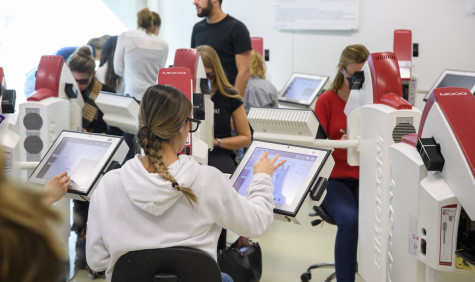"As a result of the connection, a little bit of SURF becomes a component of our infrastructure, as it were. That means we also have responsibility for it: we determine what is and isn't possible or permissible. "
'Cloudbursting' expands research infrastructure at VUmc
Researchers at the Vrije Universiteit Medical Centre (VUmc) sometimes reach the capacity limits of the private VUmc Research Cloud, which is why it is connected to SURF's HPC Cloud. Lightpaths between the Research Cloud and the HPC Cloud provide additional security, reliability, and capacity, and researchers do not even notice the difference.
Connecting cloud environments
Christiaan Geertsma is an Information Analyst in the IT department at VUmc. He explains how the cooperation came about: "Our researchers work in all kinds of cooperative groupings. We set up our Research Cloud a few years ago to support their work, and researchers can also store their data here. This Research Cloud forms the basis of our regular research work. However, our researchers need to be able to go elsewhere at peak times. That's why we've connected our environment to a virtual environment in SURF's HPC Cloud. We've come up with the great name of 'community cloudbursting' for this development."
Own responsibility
"As a result of the connection, a little bit of SURF becomes a component of our infrastructure, as it were," explains Geertsma. "That means we also have responsibility for it: we determine what is and isn't possible or permissible. First, we carried out a trial with a researcher. We are now continuing to develop the service, for example by determining who is responsible for support and for other issues." The new service should be available to all researchers from summer 2017 onwards.
Connected via a dynamic lightpath
The VUmc and SURF environments are connected by a dynamic lightpath provided by SURF. However, researchers scarcely notice the connection. According to Geertsma: "Researchers have experience with both our cloud and the HPC Cloud. The main thing is that they don't have to drag their data back and forth. They don't need to copy any datasets or to take a hard drive with them to another location. That is also a thing of the past."
Attractive for extensive datasets
Who will be attracted by this service? "It's mainly aimed at research that requires a lot of analytical work," says Geertsma. "That primarily means researchers in the field of genetics, which we often call the 'omics' – such as genomics. Another group is that of researchers who work with images such as MRI and CT scans. Currently they often use computing clusters, but cloudbursting may also be of interest to them."
"With SURF, researchers with NWO funding can use the HPC Cloud at low cost or even for free, whereas we would need to charge them a fee. In this way you get the best of two worlds."
The best of two worlds
The increase in capacity is one of the advantages; however, Geertsma believes the bigger advantage is that he no longer has to say 'no' to a researcher who needs a lot of computing power. The service is also cheaper for some researchers, adds Geertsma: "With SURF, researchers with NWO funding can use the HPC Cloud at low cost or even for free, whereas we would need to charge them a fee. In this way you get the best of two worlds."
